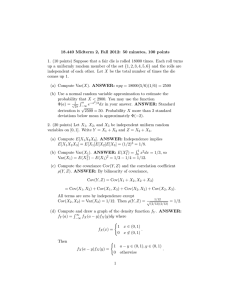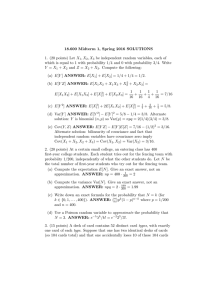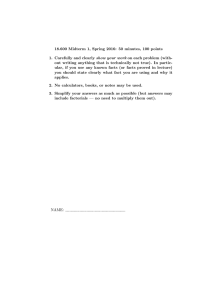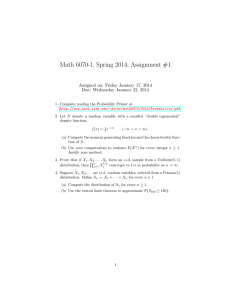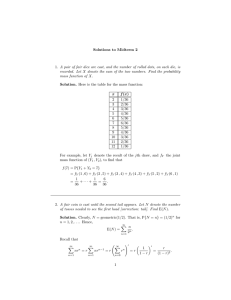18.440 Midterm 2, Fall 2012: ... 1. (10 points) Suppose that a fair die is...
advertisement
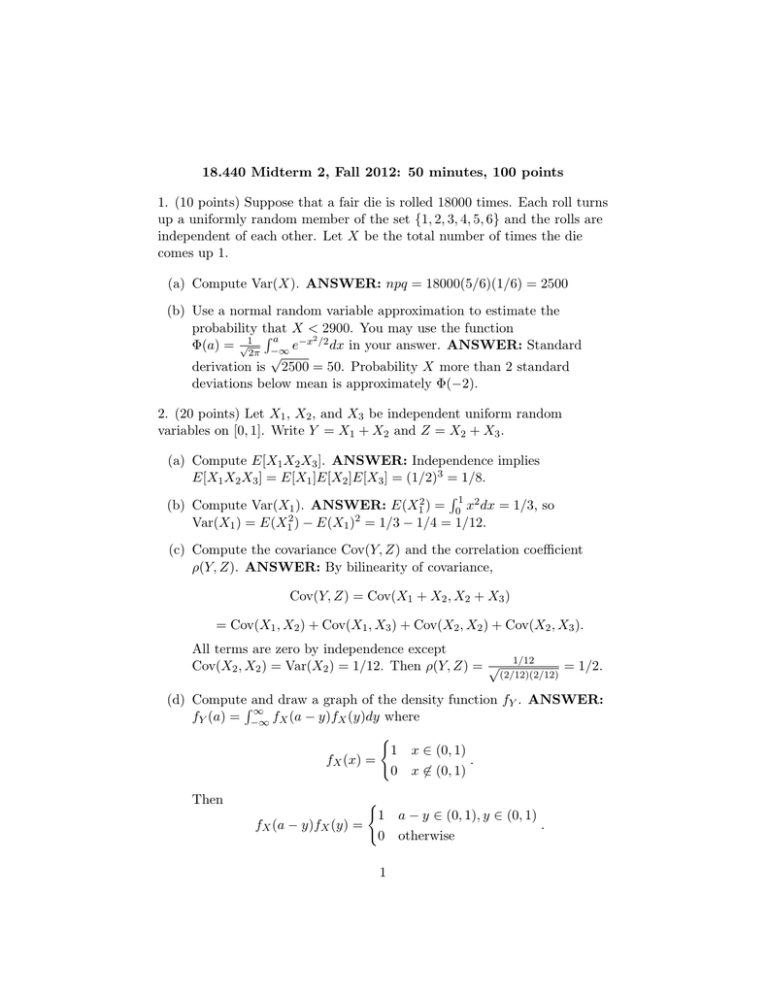
18.440 Midterm 2, Fall 2012: 50 minutes, 100 points
1. (10 points) Suppose that a fair die is rolled 18000 times. Each roll turns
up a uniformly random member of the set {1, 2, 3, 4, 5, 6} and the rolls are
independent of each other. Let X be the total number of times the die
comes up 1.
(a) Compute Var(X). ANSWER: npq = 18000(5/6)(1/6) = 2500
(b) Use a normal random variable approximation to estimate the
probability that X < 2900. You may use the function
2
a
Φ(a) = √12π −∞ e−x /2 dx in your answer. ANSWER: Standard
√
derivation is 2500 = 50. Probability X more than 2 standard
deviations below mean is approximately Φ(−2).
2. (20 points) Let X1 , X2 , and X3 be independent uniform random
variables on [0, 1]. Write Y = X1 + X2 and Z = X2 + X3 .
(a) Compute E[X1 X2 X3 ]. ANSWER: Independence implies
E[X1 X2 X3 ] = E[X1 ]E[X2 ]E[X3 ] = (1/2)3 = 1/8.
1
(b) Compute Var(X1 ). ANSWER: E(X12 ) = 0
x2 dx = 1/3, so
Var(X1 ) = E(X12 ) − E(X1 )2 = 1/3 − 1/4 = 1/12.
(c) Compute the covariance Cov(Y, Z) and the correlation coefficient
ρ(Y, Z). ANSWER: By bilinearity of covariance,
Cov(Y, Z) = Cov(X1 + X2 , X2 + X3 )
= Cov(X1 , X2 ) + Cov(X1 , X3 ) + Cov(X2 , X2 ) + Cov(X2 , X3 ).
All terms are zero by independence except
Cov(X2 , X2 ) = Var(X2 ) = 1/12. Then ρ(Y, Z) = √
1/12
(2/12)(2/12)
= 1/2.
(d) Compute and draw a graph of the density function fY . ANSWER:
∞
fY (a) = −∞ fX (a − y)fX (y)dy where
1 x ∈ (0, 1)
.
0 x ∈ (0, 1)
fX (x) =
Then
fX (a − y)fX (y) =
1 a − y ∈ (0, 1), y ∈ (0, 1)
.
0 otherwise
1
Now a − y ∈ (0, 1) is equivalent to −y ∈ (−a, 1 − a) or equivalently
y ∈ (a − 1, a). Thus fY (a) is equal to the length of the intersection of
the intervals (0, 1) and (a − 1, a). This becomes
⎧
⎪
a<0
⎪
⎪0
⎪
⎨a
0≤a<1
fY (a) =
⎪
2−a
1≤a<2
⎪
⎪
⎪
⎩
0a ≥ 2
fY (a)
1
0
2
1
a
3. (20 points) Suppose that X1 , X2 , . . . , Xn are independent uniform
random variables on [0, 1].
(a) Write Y = min{X1 , X2 , . . . , Xn }. Compute the cumulative
distribution function FY (a) and the density function fY (a) for
a ∈ [0, 1]. ANSWER: By independence, P (min{X1 , X2 , . . . , Xn } >
a) = P (X1 > a)P (X2 > a) · · · P (Xn > a) = (1 − a)n So
FY (a) = 1 − (1 − a)n , and fY (a) = FY� (a) = n(1 − a)n−1
(b) Compute P (X1 < .3) and P max{X1 , X2 , . . . , Xn } < .3.
ANSWER: .3 and .3n .
(c) Compute the expectation E[X1 + X2 + . . . + Xn ]. ANSWER: By
additivity of expectation, this is nE[X1 ] = n/2.
4. (20 points) Aspiring writer Rachel decides to lock herself in her room to
think of screenplay ideas. When Rachel is thinking, the moments at which
good new ideas occur to her form a Poisson process with parameter
λG = .5/hour. The times when bad new ideas occur to her are a Poisson
point process with parameter λB = 1.5 per hour.
(a) Let T be the amount of time until Rachel has her first idea (good or
bad). Write down the probability density function for T .
2
ANSWER: T is exponential with parameter λ = λG + λB = 2, so
fT (x) = 2e−2x .
(b) Compute the probability that Rachel has exactly 3 bad ideas total
during her first hour of thinking. ANSWER: Number N of bad
3 −1.5
ideas is Poisson with rate 1 · λB = 1.5. So P (N = 3) = (1.5)3!e
.
(c) Let S be the amount of time elapsed before the fifth good idea
occurs. Compute Var(S). ANSWER: Variance of time till one good
idea is 1/λ2G .
Memoryless property and additivity of variance of
independent sums gives Var(S) = 5/λ2G = 20.
(d) What is the probability that Rachel has no ideas at all during her
first three hours of thinking? ANSWER: Time till first idea is
exponential with λ = 2. Probability this time exceeds 3 is
e−2·3 = e−6 .
5. (20 points) Suppose that X and Y have a joint density function f given
by
(
1/π x2 + y 2 < 1
f (x, y) =
.
0
x2 + y 2 ≥ 1
(a) Compute the probability density function fX for X. ANSWER:
( √
1
∞
2 1 − x2 −1 ≤ x ≤ −1
fX (x) =
f (x, y)dy = π
0
otherwise
−∞
(b) Compute the conditional expectation E[X|Y = .5]. ANSWER:
Probability
density
for X given Y = .5 is uniform on
√
√
2
(− 1 − .5 , 1 − .52 ). So E[X|Y = .5] = 0.
(c) Express E[X 3 Y 3 ] as a double integral. (You don’t have to explicitly
evaluate the integral.) ANSWER:
1
√
1−x2
−1
√
− 1−x2
1 3 3
x y dydx.
π
6. (10 points) Let X and Y be independent normal random variables, each
with mean 1 and variance 9.
3
(a) Let f be the joint probability density function for the pair (X, Y ).
Write an explicit formula for f . ANSWER:
1
1
1 − (x−1)2 −(y−1)2
2
2
18
f (x, y) = √ e−(x−1) /18 √ e−(y−1) /18 =
e
.
18π
3 2π
3 2π
(b) Compute E[X 2 ] and E[X 2 Y 2 ]. ANSWER:
Var(X) = E[X 2 ] − E[X]2 = E[X 2 ] − 1 = 9, so E[X 2 ] = 10. By
independence E[X 2 Y 2 ] = E[X 2 ]E[Y 2 ] = 100.
4
MIT OpenCourseWare
http://ocw.mit.edu
18.440 Probability and Random Variables
Spring 2014
For information about citing these materials or our Terms of Use, visit: http://ocw.mit.edu/terms.

